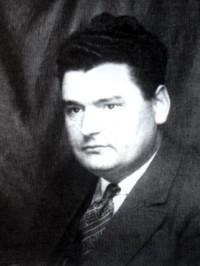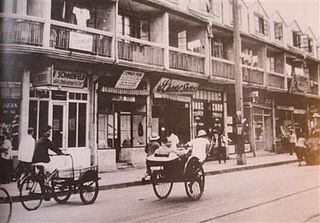Related Research Articles

Raoul Gustaf Wallenberg was a Swedish architect, businessman, diplomat, and humanitarian. He saved thousands of Jews in German-occupied Hungary during the Holocaust from German Nazis and Hungarian fascists during the later stages of World War II. While serving as Sweden's special envoy in Budapest between July and December 1944, Wallenberg issued protective passports and sheltered Jews in buildings which he declared as Swedish territory.

Henryk Sławik was a Polish politician in the interwar period, social worker, activist, and diplomat, who during World War II helped save over 30,000 Polish refugees, including 5,000 Polish Jews in Budapest, Hungary, by giving them false Polish passports with Catholic designation. He was executed with some of his fellow Polish activists on order of Reichsführer SS in concentration camp Gusen on 23 August 1944.

Chiune Sugihara was a Japanese diplomat who served as vice-consul for the Japanese Empire in Kaunas, Lithuania. During the Second World War, Sugihara helped thousands of Jews flee Europe by issuing transit visas to them so that they could travel through Japanese territory, risking his job and the lives of his family. The fleeing Jews were refugees from German-occupied Western Poland and Soviet-occupied Eastern Poland, as well as residents of Lithuania. In 1985, the State of Israel honored Sugihara as one of the Righteous Among the Nations for his actions. He is the only Japanese national to have been so honored. In Lithuania, 2020 was "The Year of Chiune Sugihara". It has been estimated as many as 100,000 people alive today are the descendants of the recipients of Sugihara visas.

During World War II, some individuals and groups helped Jews and others escape the Holocaust conducted by Nazi Germany.
Shortly prior to and during World War II, and coinciding with the Second Sino-Japanese War, tens of thousands of Jewish refugees were resettled in the Japanese Empire. The onset of the European war by Nazi Germany involved the lethal mass persecutions and genocide of Jews, later known as the Holocaust, resulting in thousands of Jewish refugees fleeing east. Most ended up in Japanese-occupied China.

Ho Feng-Shan was a Chinese diplomat and writer for the Republic of China. When he was consul-general in Vienna during World War II, he risked his life and career to save "perhaps tens of thousands" of Jews by issuing them visas, disobeying the instruction of his superiors. It is known that Ho issued the 200th visa in June 1938, signed the 1906th visa on 27 October 1938, and was recalled to China in May 1940. Ho died in 1997 and his actions were recognized posthumously when the Israeli organization Yad Vashem in 2000 awarded Ho Feng-Shan the title "Righteous Among the Nations".
Recorded Jewish history in the Philippines started during the Spanish period.

In the decades since the Holocaust, some national governments, international bodies and world leaders have been criticized for their failure to take appropriate action to save the millions of European Jews, Roma, and other victims of the Holocaust. Critics say that such intervention, particularly by the Allied governments, might have saved substantial numbers of people and could have been accomplished without the diversion of significant resources from the war effort.

The Shanghai Ghetto, formally known as the Restricted Sector for Stateless Refugees, was an area of approximately one square mile in the Hongkew district of Japanese-occupied Shanghai. The area included the community around the Ohel Moshe Synagogue. Shanghai was notable for a long period as the only place in the world that unconditionally offered refuge for Jews escaping from the Nazis. After the Japanese occupied all of Shanghai in 1941, the Japanese army forced about 23,000 of the city's Jewish refugees to be restricted or relocated to the Shanghai Ghetto from 1941 to 1945 by the Proclamation Concerning Restriction of Residence and Business of Stateless Refugees. It was one of the poorest and most crowded areas of the city. Local Jewish families and American Jewish charities aided them with shelter, food, and clothing. The Japanese authorities increasingly stepped up restrictions, surrounded the ghetto with barbed wire, and the local Chinese residents, whose living conditions were often as bad, did not leave. By 21 August 1941, the Japanese government closed Shanghai to Jewish immigration.

David H. Kranzler was an American professor of library science at Queensborough Community College, New York, who specialized in the study of the rescue of Jews during the Holocaust.

On three cases, entire countries resisted the deportation of their Jewish population during the Holocaust. In other countries, notable individuals or communities created resistance during the Holocaust which helped the Jews escape some concentration camps.

Chaim Yisroel Eiss was an Agudath Israel activist and writer. He also was among the founders of the Agudath Israel in 1912. During the First World War, Rebbe Eiss set up an aid system that located refugees, found out what they most needed and raised the required funds. During World War II, he worked on behalf of Jews in Nazi-occupied Europe and he was a member of the Ładoś Group also called as Ładoś Group.
The history of the Jews in Kobe, Japan, is recorded from the 19th century onwards.

The history of the Jews in Japan is well documented in modern times, with various traditions relating to much earlier eras.

The Shanghai Jewish Refugees Museum is a museum commemorating the Jewish refugees who lived in Shanghai during World War II after fleeing Europe to escape the Holocaust. It is located at the former Ohel Moshe or Moishe Synagogue, in the Tilanqiao Historic Area of Hongkou district, Shanghai, China. The museum features documents, photographs, films, and personal items documenting the lives of some of the more than 20,000 Jewish residents of the Restricted Sector for Stateless Refugees, better known as the Shanghai Ghetto, during the Japanese occupation of Shanghai.

After Adolf Hitler came into power in 1933, Jews began to escape German-occupied Europe.

In October 1938, about 17,000 Polish Jews living in Nazi Germany were arrested and expelled. These deportations, termed by the Nazis Polenaktion, were ordered by SS officer and head of the Gestapo Reinhard Heydrich. The deported Jews were initially rejected by Poland and therefore had to live in makeshift encampments along the Germany–Poland border.
Portugal was officially neutral during World War II and the period of the Holocaust in German-occupied Europe. The country had been ruled by an authoritarian political regime led by António de Oliveira Salazar but had not been significantly influenced by racial antisemitism and was considered more sympathetic to the Allies than was neighbouring Francoist Spain.
Although Japan was a member of the Axis, and therefore an ally of Nazi Germany, it did not actively participate in the Holocaust. Anti-semitic attitudes were not significant in Japan during World War II and there was little interest in the Jewish question, which was seen as a European issue. Furthermore, Nazi Germany did not pressure Japan on the issue.
Sweden was a neutral state during World War II and was not directly involved in the Holocaust in German-occupied Europe. Nonetheless, the Swedish government maintained important economic links with Nazi Germany and there was widespread awareness within the country of its policy of persecution and, from 1942, mass extermination of Jews.
References
- ↑ Péter Vámos, The Life of Central European Jewish Refugees in Shanghai During World War II. Pacific Rim Report No. 23, November 2001 Archived 2010-06-26 at the Wayback Machine
- ↑ Caestecker, Frank; Moore, Bob (2010-01-01). Refugees From Nazi Germany and the Liberal European States. Berghahn Books. p. 117. ISBN 978-1-84545-799-0.
- ↑ Diplomats Who Saved Jews